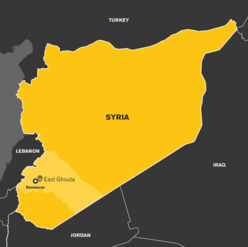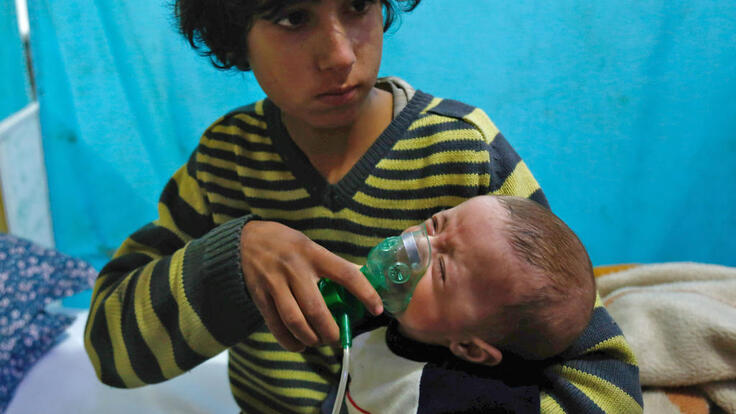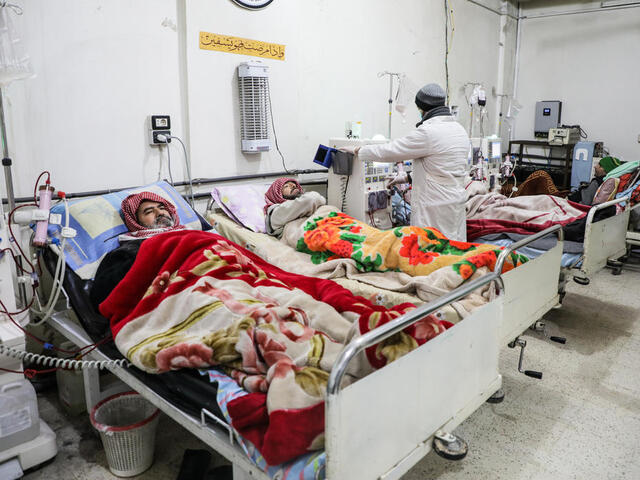The past few months have seen some of the bloodiest fighting in more than seven years of civil war in Syria as attacks intensify in Eastern Ghouta, including a suspected chemical weapons attack on April 8 in the town of Douma. The International Rescue Committee (IRC) and our partners are there providing support for civilians living under siege. Here’s what you need to know:
Where is Eastern Ghouta?
Eastern Ghouta is a suburb of Damascus. It’s the largest area controlled by armed groups near the capital city, and is suffering daily bombardment.

What is happening in Eastern Ghouta?
Nearly 400,000 people live in Eastern Ghouta, and parts have been besieged for over four years. Around half of the population have been displaced by the conflict, with 16 percent living in unfinished or abandoned buildings. Several neighborhoods remain riddled with explosives. Attacks from Eastern Ghouta have also occurred regularly over the past few years, and have also increased in recent months killing several people in residential areas of Damascus.
More than 70 civilians are reported dead in a suspected chemical attack in Douma, the last town in Eastern Ghouta controlled by armed groups.
“This is not the first time such tactics have been deployed,” says IRC senior vice president of international programs Ciaran Donnelly, referring to a suspected chemical weapons attack in Eastern Ghouta in 2013 and a sarin attack in the province of Idlib last year. “These unlawful attacks pour shame not only on the parties to the conflict, but on the international community for standing by and letting it happen.”
Why is Eastern Ghouta in the headlines?
Despite a ceasefire agreement passed on Feb. 24, recent weeks have seen a sharp escalation of hostilities in Eastern Ghouta. Since mid-February, more 1,700 people have been killed and over 5,000 injured by aerial and artillery attacks. Food, fuel, and medical supplies are running perilously low.

What is the humanitarian situation in Eastern Ghouta?
The people of Eastern Ghouta are terrified. They are sheltering for their lives in basements and makeshift dugouts as the attacks intensify. Thousands have fled their homes in recent weeks but there is nowhere safe for them to run to.
“I hear nothing but fear in people’s words,” said one resident. “Fear and anxiety that this is happening all the time. Fear and anxiety because we might be targeted.”
Civilians are being killed indiscriminately-—and medical facilities where the wounded seek treatment are being attacked. A health worker and six patients died when one IRC-supported partner hospital came under attack on Feb. 19. The hospital had treated 50 wounded people that day before damage to the building and medical equipment put it out of commission.
A nurse from another hospital supported by the IRC was killed when a bomb struck her home. Most recently, two health staff were killed after an IRC-supported partner hospital was hit by airstrikes on March 5.
According to the World Health Organization, there were 25 attacks on hospitals and health centers in Eastern Ghouta in February alone.
“The ferocity of the current bombardment means only the most urgent cases are being treated at IRC-supported health clinics, says Mark Schnellbaecher, the IRC’s Middle East regional director. “It’s just too dangerous for anyone else to travel to seek medical help.”
More than 1,000 people in Eastern Ghouta are in need of urgent medical evacuation. There have already been 22 civilian deaths among those waiting to be evacuated—we expect this number to rise.
The first convoy with critical aid for 27,000 people entered the enclave on March 5 as bombs were falling. But the fighting became so intense, it had to leave before completing the distribution.

Why does this sound familiar?
The siege of Aleppo: In late 2016, more than 250,000 people were trapped in eastern Aleppo, Syria with little food, water or fuel—and no functioning hospitals—after months of siege. Bunker-busting bombs rained down on the city. “Every night when we go to sleep, we don’t know if we will wake up under rubble,” one Aleppo resident told IRC aid workers in November 2016. “We are just waiting for our time to die.”
Residents weary from a prolonged sieged also suffered heavy bombardment. By December 2016, Syrian government forces took full control of Aleppo and tens of thousands of people fled the city.
“We have long feared Eastern Ghouta will see a repeat of the terrible scenes observed by the world during the fall of East Aleppo and these fears seem to be well founded,” Schnellbaecher says.
Who is hit hardest by the siege of Eastern Ghouta?
Residents have told the IRC that children are facing the brunt of the attacks on Eastern Ghouta.
The siege and the blocking of aid have not only contributed to a medical emergency but also a food crisis that has left many children dangerously malnourished. A tightening of the siege in July caused a sharp rise in prices and subsequently a food crisis, which by November had left twelve percent of children under five with acute malnutrition.
As well as the widespread malnutrition, schools in Eastern Ghouta have been closed since the beginning of January because of the increased attacks. Many children have to work to bring in money to help their families buy food.
How is the IRC responding?
Since January the IRC through its partners has been providing nutritional supplements to more than 3,300 malnourished children in the enclave. The IRC also covers salaries and basic operating costs, medicines and medical supplies at the five partner-run medical facilities we support in Eastern Ghouta.
According to the IRC’s partners, medical staff are more stretched than they have been since the area came under siege four years ago. Health workers have resorted to reusing syringes, and families taking expired medicine, and there are thousands of people with chronic diseases suffering without necessary care.
What can be done?
The only way to end the humanitarian crisis is to end the fighting, lifting the siege to allow essential food and medicine into the area and to allow urgent medical evacuations for the gravely ill.
“As government forces continue their offensive, the horrors we have previously seen in Eastern Ghouta, Homs, Idlib and elsewhere must not be repeated,” says the IRC’s Donnelly. “Actors supported by the United States and Russia—as well as the United Nations Security Council—must make the protection of civilians their number one priority.”
“My family and I are living in constant stress and depression,” says a Syrian paramedic working with one of the IRC’s local partners in Eastern Ghouta. “Every day, I pray and hope the conflict will end… My dream is to see my city free, without siege.”
What can I do to help?
Support the IRC’s lifesaving work in Syria and other conflict-ridden places around the world. Donate now.
Help raise awareness of this humanitarian crisis and call for action by sharing our updates from Syria in your social media channels.
PRESS RELEASE: Suspected chemical attack in #EasternGhouta further demonstrates that the government of Syria will stop at nothing to win this war. https://t.co/YGLCMwRUtd
— International Rescue Committee - Europe (@IRCEurope) April 8, 2018
Learn more
Across Syria, the International Rescue Committee provides lifesaving support to 1 million people—almost half of them children—who are struggling to survive a brutal war now in its eighth year. Learn more about our work in Syria.